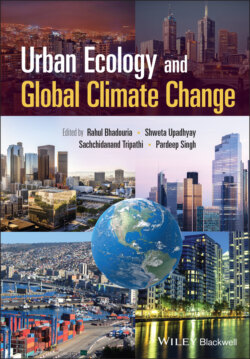Читать книгу Urban Ecology and Global Climate Change - Группа авторов - Страница 26
1.5 Emerging Features of Urban Ecology for Mitigating Climate Change
ОглавлениеUrban ecosystems around the world are facing several major challenges among which increasing human population and climate change are the most prominent, making the sustainable urban development an elusive phenomenon (Childers et al. 2015). An increase in the frequency of extreme weather events induced by the climate change scenario is jeopardising the urban planners and designers to develop concrete adaptive measures for the urban settlements for the long term (Kattel et al. 2013; Steiner 2014). Thus, for sustainable cities, novel solutions and techniques for landscape planning having the potential of resilience and self‐regulation from the extreme climatic conditions are needed (Childers et al. 2015; Yu et al. 2017). In this regard, urban vegetation can play a major role by managing the energy/radiation balance of the physical environment through the process of photosynthesis, evapotranspiration, and shadowing effects (Oke 2002; Yu et al. 2017). Moreover, Steiner (2014) highlighted four potential urban ecological design/planning measures, viz. application of ecosystem services, adaption of settlements for the natural disasters by managing green infrastructures, renewal of degraded landscapes, and improving the adaptive behaviour of people by linking knowledge about the surroundings to the actions.
The thematic evolution showed that there is a transitional shift in research focus during the last two decades (Figure 1.2). It can be seen that for the 2005–2014 period, social (climate change, urbanisation, and rural gradients) and ecological (phenology, conservation, vegetation, and UHI effect) aspects hold almost equal importance which get diversified in different emerging ecological aspects like ecology, ecosystem services, communities, resilience, and water during the 2015–2021 period. The 2015–2021 period showed the convergence of climate change and urbanisation, and conservation, whereas diversification of vegetation and conservation into communities, ecosystem services, ecology, and resilience showed that more research emphasis has now been given on ecosystem resilience and self‐sustaining systems for the climate change mitigation. Moreover, the role of spatial modelling tools such as remote sensing and geographic information system (GIS) for developing sustainable urban ecosystems by vegetation mapping and risk analysis by the extreme weather events (climate change) has also been evolving considerably. Moreover, the role of vegetation phenology and its impact on various ecosystem services under the changing climatic conditions is also getting wider attention. The challenges to the urban ecosystems and adaptation strategies for the climate change have been briefly illustrated in Figure 1.3. In the next few sub‐sections, ecosystem services and green infrastructure‐related aspects have been elaborated while less emphasis has been given on later two mitigation measures in this chapter.
Figure 1.2 Thematic evolution of the urban ecology and climate change research areas during the last two decades.
Source: Data from Web of Science Core Collection database (2021).
Figure 1.3 Illustrative representation of the challenges of the urban ecosystems and climate change adaptation strategies.
